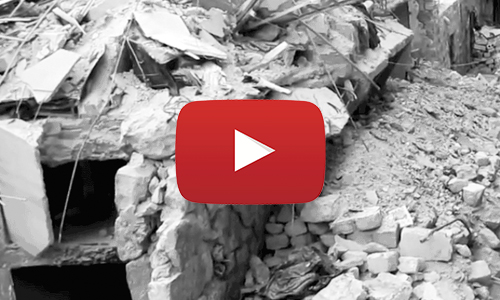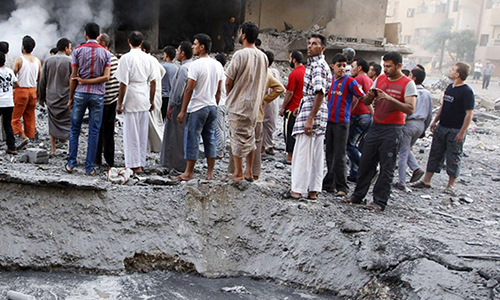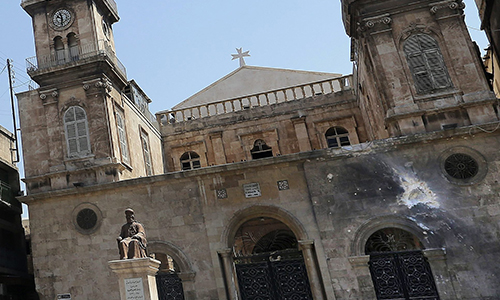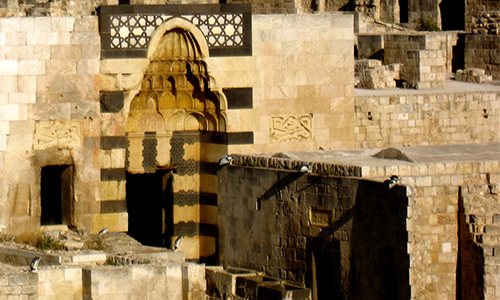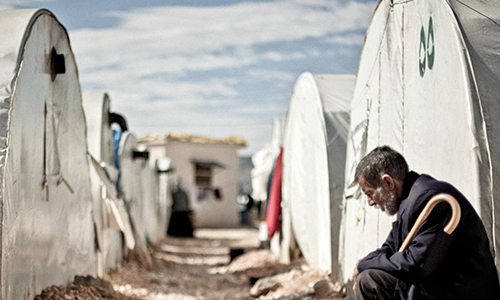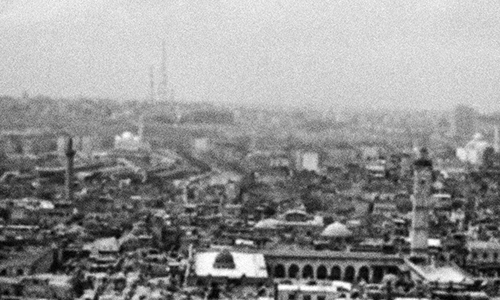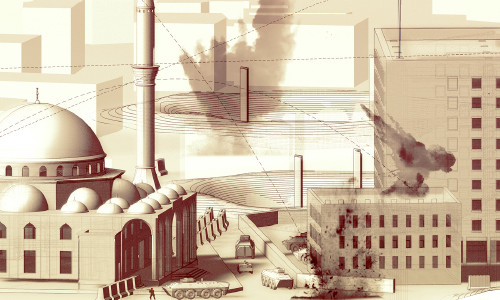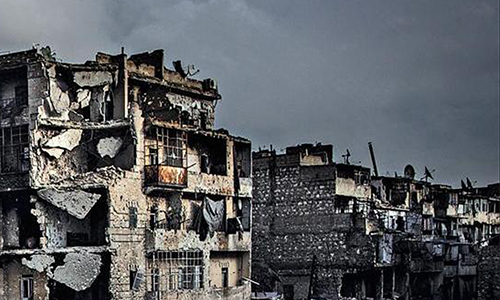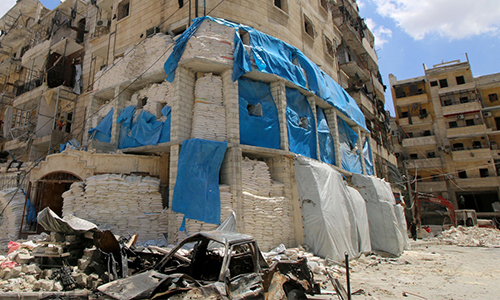SPATIALIZING SYRIA'S
YOUTUBE WAR
This project is an investigation of the YouTube war, investigating the platform as a means to better understand the physical destruction and humanitarian crisis in the city. While Western based non-profit organizations note barrel bomb destruction that can be viewed from satellite imagery, the footage accessible online provides an opportunity to understand the conflict with a greater depth of realism. This project is a mapping of the spatial relevance and political meaning of the ‘YouTube War’
GO TO PROJECTALEPPO
MEMORY MAP
Every city is, among other things, a rich repository of stories. The Aleppo Memory Map attempts to capture some of Aleppo's stories, allowing listeners to explore what the city means to those who know it best. Click on a marker, and a short audio file pops up: a memory of summers spent playing with cousins, or of poetry readings at a neighborhood church. The map contains no images, attempting instead to paint a verbal portrait of the city as seen through the eyes of its citizens. In doing so, it aims to capture some of the pride and affection that Aleppans feel for their city.
GO TO PROJECTTHE CURRENT STATE
OF ALEPPO'S ROADS
Prior to the conflict, Syria’s road network was highly trafficked but poorly maintained and unsafe due to poor construction, operation, and maintenance. Heavy loads from freight trucks and weathering over time caused numerous cracks and potholes throughout Syria’s road network. In addition to these variables, poor initial construction and poor maintenance of Syrian roads has led to numerous fatalities and accidents throughout the country according to local news reports from 2006.1
In this study, I obtained background transportation research from the University of Damascus in order to study the road network of Syria. I then conducted a spatial analysis of current damage in Aleppo using data from the United Nations- UNITAR’s Operational Satellite Applications Programme (UNOSAT).
GO TO PROJECTCHRISTIANS OF
ALEPPO
On a sunny evening in April, during Orthodox Holy Week, about 75 people gathered at W83, a New York City community center and event space owned by Redeemer Presbyterian Church, for traditional Syrian orthodox chants in honor of orthodox holy week. This example of a Syrian Orthodox musical performance represents the attempts of an ancient religious community to maintain their religious practice and cultural heritage in the face of violence against Christians in Syria.
GO TO PROJECTCREATION OF BORDERS
IN WARTIME ALEPPO
Historically, Aleppo is a city that has been defined and redefined by its borders. The Romans, early Muslims, Abuyyids, Ottomans, French, post-independence regimes, and others have all destroyed, adapted, and expanded the borders of the previous period.
Allowing that the war might be one more step in this continuous redrawing of boundaries, I studied satellite imagery of the frontlines and identified three emerging categories of new, wartime borders. In the next sections I will examine a case study of each of the following:
Go To ProjectREFUGEE CAMPS AS
REPLACEMENT URBANISM
The camp has become the new reality, and the new urbanity, for those fleeing Aleppo. Hastily constructed but inhabited for years, the refugee camp is its own type of city, carceral but also safe, secure but also hopeless. This case study looks at several of the camps on the Syria-Turkey border on the route from Aleppo to Turkey and beyond, examining them as the type of urbanism that stems from conflict.
GO TO PROJECTWATER AS A
WAR WEAPON
The Syrian civil war has leveled cities, uprooted thousands of families, and forced a refugee crisis of a scale not witnessed since the Second World War. Of the many inhuman brutalities inflicted upon the residents of Syria, barrel bombs dropped by regime forces, torture at the hands of ISIS militants, the blockading of food and medical supplies, and the intentional targeting of non-combatants, the weaponization of the water infrastructure represents a uniquely viscous attack against civilians. Residents throughout the divided city of Aleppo describe finding safe water as a constant struggle.
GO TO PROJECTCOMMUNICATIONS
INFRASTRUCTURE
The camp has become the new reality, and the new urbanity, for those fleeing Aleppo. Hastily constructed but inhabited for years, the refugee camp is its own type of city, carceral but also safe, secure but also hopeless. This case study looks at several of the camps on the Syria-Turkey border on the route from Aleppo to Turkey and beyond, examining them as the type of urbanism that stems from conflict.
GO TO PROJECTPLAYGROUNDS OF
WAR
Like a single picture composed of stitched images, this urban section couples distinct viewports to render a cohesive depiction of the conflict at its most consequential scale, simultaneously mitigating the sensory chaos of first-person footage and the abstraction of satellite imagery. Looking west, the drawing reveals the southeastern part of the Citadel (the urban theater right in the center of the Battle for Aleppo) and it unstable spatial demarcations.
GO TO PROJECTALGORYTHMIC
IMAGINARIES OF ESCAPE
As the situation in Syria has shifted over the course of the civil war from government-sponsored violence against civilians protesting in cities like Homs to the current picture of a global refugee crisis now pushing on the borders of Europe, critical attention has drifted along extended avenues of escape and humanitarian resources have organized around the already displaced.
This case study concerns the immediate possibilities of flight from a seemingly depopulated city of Aleppo, now a decisive front of the ongoing conflict.
GO TO PROJECTINFORMAL
SETTLEMENTS
The camp has become the new reality, and the new urbanity, for those fleeing Aleppo. Hastily constructed but inhabited for years, the refugee camp is its own type of city, carceral but also safe, secure but also hopeless. This case study looks at several of the camps on the Syria-Turkey border on the route from Aleppo to Turkey and beyond, examining them as the type of urbanism that stems from conflict.
GO TO PROJECTMEDICAL FACILITIES
IN ALEPPO
In a civil war marked by base savagery, one of the greatest crimes committed against the Syrian people has been the routine targeting of their medical facilities. Civilians and militants alike have been affected by this blatant disregard for basic human decency. While war crimes against medical professionals and civilians have been committed by both rebel and regime forces, the greater military power of the Syrian government and their Russian allies, has damaged or destroyed much of the medical infrastructure in rebel held Aleppo. This portion of the case study investigates this particular strain of inhumanity.
GO TO PROJECTFaculty
| Name | Project role | Title | |
|---|---|---|---|
| Laura Kurgan | Principal Investigator | Graduate School of Architecture, Planning and Preservation | ljk33@columbia.edu |
| Madeeha Merchant | Project Lead | Graduate School of Architecture, Planning and Preservation | mym2107@columbia.edu |
| Jamon Van Den Hoek | Collaborator | Graduate School of Architecture, Planning and Preservation | vandenhj@oregonstate.edu |
| Grga Basic | Research Associate | Graduate School of Architecture, Planning and Preservation | gb2559@columbia.edu |
| Mike Howard | Research Assistant | Graduate School of Architecture, Planning and Preservation | msh2183@columbia.edu |
Students
| Name | School | Program |
|---|---|---|
| Aaron Febuary | Graduate School of Architecture, Planning and Preservation | Master of Science in Urban Planning |
| Alexander Cox | School of International and Public Affairs | Master of Public Adminstration |
| Alexandra Diaz | Graduate School of Architecture, Planning and Preservation | Master of Science in Urban Planning |
| Amanda Chan | Graduate School of Architecture, Planning and Preservation | Master of Science in Urban Design |
| Anjali Singhvi | Graduate School of Architecture, Planning and Preservation | Master of Science in Urban Planning |
| Ashwini Karanth | Graduate School of Architecture, Planning and Preservation | Master of Science in Urban Design |
| Caitlin Miller | Department of Art History and Archeology | Doctor for Philosophy Art History |
| Darcy Alexandra Coulter | Graduate School of Arts and Sciences, Graduate School of Journalism | Master of Arts in Religion/Master of Science in Journalism |
| Despo Thoma | Graduate School of Architecture, Planning and Preservation | Master of Science in Advanced Architectural Design |
| Eva Johanna Schreiner | Graduate School of Architecture, Planning and Preservation | Doctor of Philosophy in Architecture |
| Gabrielle Printz | Graduate School of Architecture, Planning and Preservation | Master of Science in Critical, Curatorial & Conceptual Practices |
| Gayatri Kawlra | Global Thought | Master of Arts in Global Thought |
| Grace Mills | Graduate School of Architecture, Planning and Preservation | Master of Science in Urban Design |
| Hasbrouck Miller | Department of Art History and Archeology | Doctor of Philosophy in Art History |
| Jason Danforth | Graduate School of Architecture, Planning and Preservation | Master of Architecture |
| Javier Bidot-Betancourt | Graduate School of Architecture, Planning and Preservation | Master of Science in Advanced Architectural Design |
| Jay Logan Clark | Graduate School of Architecture, Planning and Preservation | Master of Science in Urban Planning |
| Jessica Engebretson | Graduate School of Arts and Sciences | Doctor of Philosophy in English |
| Joachim Hackl | Graduate School of Architecture, Planning and Preservation | Master of Science in Critical, Curatorial & Conceptual Practices |
| John Darcey | Graduate School of Architecture, Planning and Preservation | Master of Science in Urban Planning |
| Michael Storm | Graduate School of Architecture, Planning and Preservation | Master of Science in Architecture |
| Nadine Fattaleh | Columbia College | Bachelor of Arts in Economics and Sustainable Development |
| Nicolas Russell | Graduate School of Architecture, Planning and Preservation | Master of Science in Urban Design |
| Violet Whitney | Graduate School of Architecture, Planning and Preservation | Master of Architecture |
